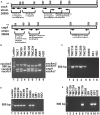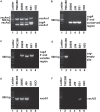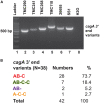Low Bifidobacterium Abundance in the Lower Gut Microbiota Is Associated With Helicobacter pylori-Related Gastric Ulcer and Gastric Cancer
- PMID: 33717022
- PMCID: PMC7953064
- DOI: 10.3389/fmicb.2021.631140
Low Bifidobacterium Abundance in the Lower Gut Microbiota Is Associated With Helicobacter pylori-Related Gastric Ulcer and Gastric Cancer
Abstract
Helicobacter pylori infection in stomach leads to gastric cancer, gastric ulcer, and duodenal ulcer. More than 1 million people die each year due to these diseases, but why most H. pylori-infected individuals remain asymptomatic while a certain proportion develops such severe gastric diseases remained an enigma. Several studies indicated that gastric and intestinal microbiota may play a critical role in the development of the H. pylori-associated diseases. However, no specific microbe in the gastric or intestinal microbiota has been clearly linked to H. pylori infection and related gastric diseases. Here, we studied H. pylori infection, its virulence genes, the intestinal microbiota, and the clinical status of Trivandrum residents (N = 375) in southwestern India by standard H. pylori culture, PCR genotype, Sanger sequencing, and microbiome analyses using Illumina Miseq and Nanopore GridION. Our analyses revealed that gastric colonization by virulent H. pylori strains (vacAs1i1m1cagA+) is necessary but not sufficient for developing these diseases. Conversely, distinct microbial pools exist in the lower gut of the H. pylori-infected vs. H. pylori-non-infected individuals. Bifidobacterium (belonging to the phylum Actinobacteria) and Bacteroides (belonging to the phylum Bacteroidetes) were present in lower relative abundance for the H. pylori+ group than the H. pylori- group (p < 0.05). On the contrary, for the H. pylori+ group, genus Dialister (bacteria belonging to the phylum Firmicutes) and genus Prevotella (bacteria belonging to the phylum Bacteroidetes) were present in higher abundance compared to the H. pylori- group (p < 0.05). Notably, those who carried H. pylori in the stomach and had developed aggressive gastric diseases also had extremely low relative abundance (p < 0.05) of several Bifidobacterium species (e.g., B. adolescentis, B. longum) in the lower gut suggesting a protective role of Bifidobacterium. Our results show the link between lower gastrointestinal microbes and upper gastrointestinal diseases. Moreover, the results are important for developing effective probiotic and early prognosis of severe gastric diseases.
Keywords: Bifidobacterium; H. pylori; gastric ulcer and cancer; gut microbiome; probiotic.
Copyright © 2021 Devi, Devadas, George, Gandhimathi, Chouhan, Retnakumar, Alexander, Varghese, Dharmaseelan, Chandrika, Jissa, Das, Nair and Chattopadhyay.
Conflict of interest statement
AG was employed by the company Genotypic Technology Pvt. Ltd, Bengaluru, Karnataka, India. The NGS was outsourced to this company. Some of the analysis was done by AG upon request in the absence of any commercial or financial relationships. The remaining authors declare that the research was conducted in the absence of any commercial or financial relationships that could be construed as a potential conflict of interest.
Figures






Similar articles
-
Effects of Helicobacter pylori Therapy on Gut Microbiota: A Systematic Review and Meta-Analysis.Dig Dis. 2024;42(1):102-112. doi: 10.1159/000527047. Epub 2022 Oct 13. Dig Dis. 2024. PMID: 36228588
-
Changes in gastric microbiota induced by Helicobacter pylori infection and preventive effects of Lactobacillus plantarum ZDY 2013 against such infection.J Dairy Sci. 2016 Feb;99(2):970-981. doi: 10.3168/jds.2015-10510. Epub 2015 Dec 17. J Dairy Sci. 2016. PMID: 26709179
-
Gastrointestinal microbiome and Helicobacter pylori: Eradicate, leave it as it is, or take a personalized benefit-risk approach?World J Gastroenterol. 2022 Feb 21;28(7):766-774. doi: 10.3748/wjg.v28.i7.766. World J Gastroenterol. 2022. PMID: 35317277 Free PMC article.
-
Gastrointestinal microbiome in the context of Helicobacter pylori infection in stomach and gastroduodenal diseases.Prog Mol Biol Transl Sci. 2022;192(1):53-95. doi: 10.1016/bs.pmbts.2022.07.001. Epub 2022 Aug 18. Prog Mol Biol Transl Sci. 2022. PMID: 36280325
-
The Influence of Gastric Microbiota and Probiotics in Helicobacter pylori Infection and Associated Diseases.Biomedicines. 2024 Dec 30;13(1):61. doi: 10.3390/biomedicines13010061. Biomedicines. 2024. PMID: 39857645 Free PMC article. Review.
Cited by
-
Gut Microbiota Characterization in Patients with Asymptomatic Hyperuricemia: probiotics increased.Bioengineered. 2021 Dec;12(1):7263-7275. doi: 10.1080/21655979.2021.1976897. Bioengineered. 2021. PMID: 34590550 Free PMC article.
-
Microbiota and gastric cancer: from molecular mechanisms to therapeutic strategies.Front Cell Infect Microbiol. 2025 Jun 3;15:1563061. doi: 10.3389/fcimb.2025.1563061. eCollection 2025. Front Cell Infect Microbiol. 2025. PMID: 40529304 Free PMC article. Review.
-
From Gut to Eye: Exploring the Role of Microbiome Imbalance in Ocular Diseases.J Clin Med. 2024 Sep 21;13(18):5611. doi: 10.3390/jcm13185611. J Clin Med. 2024. PMID: 39337098 Free PMC article. Review.
-
Application of third-generation sequencing in cancer research.Med Rev (2021). 2021 Oct 21;1(2):150-171. doi: 10.1515/mr-2021-0013. eCollection 2021 Dec. Med Rev (2021). 2021. PMID: 37724303 Free PMC article.
-
The Anti-Elixir Triad: Non-Synced Circadian Rhythm, Gut Dysbiosis, and Telomeric Damage.Med Princ Pract. 2025;34(3):212-225. doi: 10.1159/000542557. Epub 2024 Nov 13. Med Princ Pract. 2025. PMID: 39536739 Free PMC article. Review.
References
-
- Atherton J. C., Cao P., Peek R. M., Jr., Tummuru M. K., Blaser M. J., Cover T. L. (1995). Mosaicism in vacuolating cytotoxin alleles of Helicobacter pylori. Association of specific vacA types with cytotoxin production and peptic ulceration. J. Biol. Chem. 270 17771–17777. 10.1074/jbc.270.30.17771 - DOI - PubMed
Grants and funding
LinkOut - more resources
Full Text Sources
Other Literature Sources
Miscellaneous

